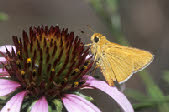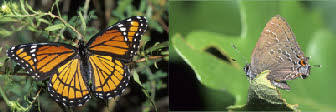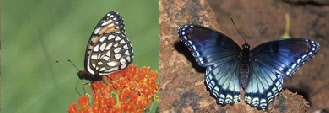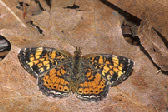The Butterflies of the World Foundation
A Non-




Diana Fritillary
Speyeria diana, Cramer, 1777
Subfamily Heliconiinae
Tribe Argynnini

Taxonomy
The family Nymphalidae is the largest butterfly family and includes about 6,000 species which are further divided up into 12 subfamilies. The common name for the family is the Brushfoots or Brushfooted Butterflies. This strange name is because the first pair of legs are significantly reduced, sometimes to mere stubs, and look like little brushes. Some of the most common and well known species are in this group such as the Monarch, Red Admiral, Blue Morpho and Painted Lady. Some of the longest lived butterflies are in this family with some species living over 10 months as adults. The Brushfoots are distributed worldwide, with the highest diversity found in the tropics. With this variety, there is also quite a difference in behavior, adult food choices and habitat preference from species to species.
All photographs, artwork, text and website design are the property of The Butterflies of the World Foundation (unless otherwise stated) and are protected under national and international copyright laws. Photographs, artwork or text on this website may not be reproduced in any way without prior written consent of The Butterflies of the World Foundation.
Speyeria diana, Ouachita National Forest, Beech Creek, Le Flore County, Oklahoma,
28 June 2010 Ref
#: I-

Speyeria diana, Ouachita National Forest, Beech Creek, Le Flore County, Oklahoma,
28 June 2010 Ref
#: I-

Speyeria diana, Ouachita National Forest, Beech Creek, Le Flore County, Oklahoma,
28 June 2010 Ref
#: I-

Speyeria diana, Ouachita National Forest, Beech Creek, Le Flore County, Oklahoma,
28 June 2010 Ref
#: I-

Speyeria diana, Ouachita National Forest, Beech Creek, Le Flore County, Oklahoma,
28 June 2010 Ref
#: I-
General Information:
Speyeria diana belongs to the subfamily Heliconiinae. This species is extremely sexually dimorphic and the female is a mimic of the poisonous Pipevine Swallowtail. At one point in history, the males and females were thought to be a different species. This stunning species is found in the Ozark Mountains of Missouri and Arkansas as well as the southern Appalachians from central Virginia and West Virginia through the mountains to northern Georgia and Alabama. Its preferred habitat includes fields, edges, and openings in moist, rich, forested mountains and valleys.
Lifecycle:
The larval food source includes many species of violets, Viola sp. Males patrol for females in deep woods. Females walk along the ground laying single eggs on dead twigs and leaves near violets. The caterpillars hatch and overwinter without feeding and in the spring they feed on leaves and flowers of violets.